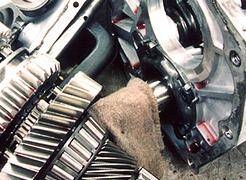
The tools needed to correct flaws in vehicle transmissions and the way they use gears during operation are a special lot to get the job done right. A transmission shop will have technicians that understand how to use a transmission jack, air-drive socket wrenches, pry bars, dynamometer and parts cleaners which are a prerequisites to completing a transmission rebuild, installation, or removal. Once the work inside the transmission is completed, it is necessary to place the transmission in its place under the vehicle and this is completed with the assistance of a special type of lifting jack.
Raise the transmission using a car lift to approximately 60 inches. This distance from the floor is the perfect height to begin removing or installing a transmission in the car. Using a transmission jack to remove the transmission fluid, check the valve body and install a transmission or remove one can begin once the transmission or the empty transmission space is at the proper height for use.
Connect the compressed air lines to the snap connector of the transmission jack's air inlet valve. Installation or removal of a transmission using a quality air jack involves centering the weight onto the extending transmission jack arm. At the top of the extending arm is a plate that is large enough to place the transmission pan onto it and allow for some securing of the transmission in one place. With a transmission secured to its frame, the jack makes it easier to carry the heavy weight of even the smallest transmission models.
Center the jack under the raised vehicle so that the jack arm can extend up to the fluid pan of the transmission. Use the compressed air to extend the jack so that it pushes up the transmission slightly, taking the weight off the bolts that secure it to the vehicle. Now the transmission can be unsecured from the vehicle and the jack can lower the weight once the removal has occurred.
Secure the transmission onto the jack's top plate. Using accessory straps, or a shim to make a better fit for the transmission pan onto the top plate of transmission jack's support system. Securing the transmission to the jack before moving the transmission from one area to another must be completed to avoid damage or injury from falling equipment.
Drain and clean the fluid container when using a transmission jack. Siphon the fluid from the retention container on the transmission jack into a larger 50-gallon drum for recycling at a later time. Disconnect the compressed air and store in a clean area. Lubricate bearings with grease and maintain all transmission securing apparatus that is included with the original purchase of the transmission jack and keep handy for future reference and use.